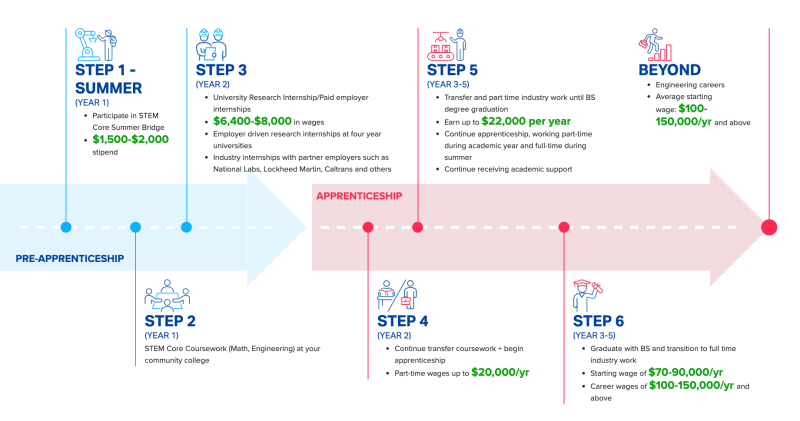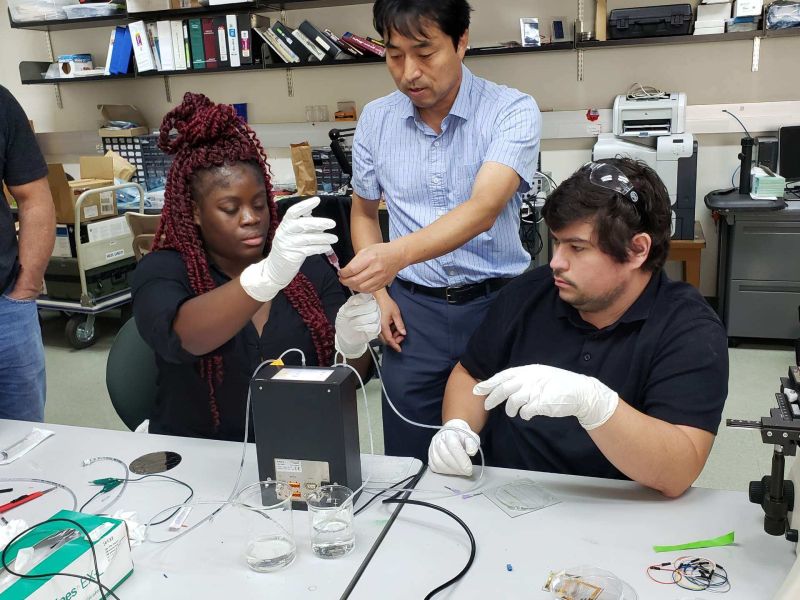Improving America’s workforce: Promoting American prosperity through STEM education – National Science Foundation (.gov)


Advancing STEM Education and Workforce Development to Support Sustainable Development Goals
Science, technology, engineering, and mathematics (STEM) fields are rapidly evolving, driving economic growth and innovation across the United States. Emerging areas such as artificial intelligence, quantum computing, and biotechnology hold significant potential to generate widespread economic and societal benefits. To harness these opportunities, a well-educated and diverse STEM workforce is essential, aligning closely with the United Nations Sustainable Development Goals (SDGs), particularly SDG 4 (Quality Education), SDG 8 (Decent Work and Economic Growth), and SDG 9 (Industry, Innovation, and Infrastructure).
The U.S. National Science Foundation (NSF) supports multiple initiatives aimed at cultivating American STEM talent and fostering inclusive economic development. Key programs include the First2 Network, the STEM Core Alliance, and the HBCU CHIPS Network. These projects address diverse regional and demographic needs, contributing to sustainable economic growth and innovation.
1. Building STEM Talent Pathways in Rural Communities
The First2 Network focuses on enhancing STEM education and career pathways in rural areas of West Virginia and neighboring states. By partnering with first-generation and economically disadvantaged students and faculty, the network addresses educational barriers such as academic preparation and financial support. This initiative supports SDG 4 by promoting inclusive and equitable quality education.
- Network Composition:
- Over 1,200 members and 30 organizational partners
- Includes students, high school teachers, colleges, universities, nonprofits, and STEM industry partners
- Impact:
- Reduced college withdrawal rates among first-generation STEM students from nearly 70% to less than 30%
- Strengthened collaboration between universities, community colleges, and industry partners
- Increased STEM degree completion and local employment through the WV Jobs Network
This initiative supports SDG 10 (Reduced Inequalities) by empowering underrepresented populations and contributes to SDG 8 by fostering decent work and economic growth in rural communities.

2. Mastering Mathematics for STEM Careers
The STEM Core Alliance addresses challenges in advanced mathematics education, a critical gateway to STEM careers. By integrating accelerated math courses, cohort-based learning, and paid industry internships, the alliance enhances student readiness and retention, directly supporting SDG 4 and SDG 8.
- Accelerated Math Course Sequences:
- Enable students to become calculus-ready within two semesters
- Cohort-Based Learning:
- Promotes peer collaboration, teamwork, and self-efficacy
- Paid Industry Internships:
- Provide practical experience and financial support
- Enhance employability and professional networks
The alliance collaborates with multiple colleges and industries, including power, construction, software, and national laboratories, contributing to SDG 9 by fostering innovation and infrastructure development.

3. Ensuring Semiconductor and Microelectronics Independence
The HBCU CHIPS Network, involving historically Black colleges and universities and community colleges in partnership with Georgia Institute of Technology, supports American leadership in microelectronics manufacturing. This initiative aligns with SDG 9 by advancing industry innovation and infrastructure, and SDG 16 (Peace, Justice, and Strong Institutions) by enhancing national security.
- Network Focus Areas:
- Device design, semiconductor materials, circuit integration, and photonics
- Consolidation of resources and expertise across institutions
- Collaborations:
- Industry partners including Microsoft, Google, Micron, and Boeing
- National Security Implications:
- Supports military technological advantage through advanced microelectronics research

Conclusion
Maintaining American leadership in STEM research, innovation, and workforce development is critical for sustainable economic prosperity and social equity. The NSF’s targeted investments in diverse STEM education programs promote inclusive quality education (SDG 4), foster decent work and economic growth (SDG 8), and drive innovation and resilient infrastructure (SDG 9). By supporting individuals from varied backgrounds and regions, these initiatives contribute to reducing inequalities (SDG 10) and enhancing national security (SDG 16), thereby advancing the United States’ commitment to the Sustainable Development Goals.
About the Authors
Lenore K. Pedicord
Communications Specialist (Contractor) at the U.S. National Science Foundation Directorate for STEM Education. Lenore crafts narratives highlighting the impact of STEM education and accessibility. She holds a bachelor’s degree in environmental science and policy and a master’s degree in science communication from George Mason University.
Caroline Kolar
Web Communications Writer and Media Specialist (Contractor) with the U.S. National Science Foundation. Caroline specializes in content marketing and communications, focusing on public awareness of scientific research and technological advancements, particularly within the Graduate Research Fellowship Program.
1. Sustainable Development Goals (SDGs) Addressed or Connected to the Article
- SDG 4: Quality Education
- The article highlights efforts to improve STEM education, particularly for first-generation and economically disadvantaged students in rural communities.
- Programs like the First2 Network and STEM Core Alliance focus on enhancing educational access, retention, and success in STEM fields.
- SDG 8: Decent Work and Economic Growth
- By building a skilled STEM workforce, the article addresses economic growth through innovation and employment opportunities.
- Connections with industry partners and paid internships support workforce development and economic prosperity.
- SDG 9: Industry, Innovation, and Infrastructure
- The article discusses advancing microelectronics and semiconductor manufacturing through the HBCU CHIPS Network, supporting innovation and infrastructure.
- Collaboration between universities, industries, and national labs fosters technological advancement.
- SDG 10: Reduced Inequalities
- Targeting first-generation, economically disadvantaged, and minority students (including historically Black colleges and universities) addresses social and educational inequalities.
- SDG 17: Partnerships for the Goals
- The article emphasizes multi-sector partnerships among educational institutions, industries, nonprofits, and government agencies to achieve STEM education and workforce goals.
2. Specific Targets Under the Identified SDGs
- SDG 4: Quality Education
- Target 4.3: Ensure equal access for all women and men to affordable and quality technical, vocational and tertiary education, including university.
- Target 4.4: Increase the number of youth and adults who have relevant skills, including technical and vocational skills, for employment and entrepreneurship.
- SDG 8: Decent Work and Economic Growth
- Target 8.5: Achieve full and productive employment and decent work for all women and men, including young people and persons with disabilities.
- Target 8.6: Reduce the proportion of youth not in employment, education or training.
- SDG 9: Industry, Innovation, and Infrastructure
- Target 9.5: Enhance scientific research, upgrade technological capabilities of industrial sectors, including encouraging innovation and increasing the number of research and development workers.
- SDG 10: Reduced Inequalities
- Target 10.2: Empower and promote the social, economic and political inclusion of all, irrespective of age, sex, disability, race, ethnicity, origin, religion or economic or other status.
- SDG 17: Partnerships for the Goals
- Target 17.17: Encourage and promote effective public, public-private and civil society partnerships.
3. Indicators Mentioned or Implied to Measure Progress
- SDG 4 Indicators
- Indicator 4.3.1: Participation rate of youth and adults in formal and non-formal education and training in the previous 12 months.
- Indicator 4.4.1: Proportion of youth and adults with information and communications technology (ICT) skills, by type of skill.
- Retention and graduation rates of first-generation and economically disadvantaged STEM students (implied by the article’s mention of withdrawal rates).
- SDG 8 Indicators
- Indicator 8.5.2: Unemployment rate, by sex, age and persons with disabilities.
- Proportion of youth engaged in employment, education or training (implied through internships and job network connections).
- SDG 9 Indicators
- Indicator 9.5.1: Research and development expenditure as a proportion of GDP.
- Number of researchers per million inhabitants (implied through the expansion of microelectronics research networks).
- SDG 10 Indicators
- Indicator 10.2.1: Proportion of people living below 50% of median income, by age, sex and persons with disabilities (implied by targeting economically disadvantaged students).
- SDG 17 Indicators
- Indicator 17.17.1: Amount of United States dollars committed to public-private partnerships (implied by multi-sector collaborations).
4. Table: SDGs, Targets and Indicators
| SDGs | Targets | Indicators |
|---|---|---|
| SDG 4: Quality Education |
|
|
| SDG 8: Decent Work and Economic Growth |
|
|
| SDG 9: Industry, Innovation, and Infrastructure |
|
|
| SDG 10: Reduced Inequalities |
|
|
| SDG 17: Partnerships for the Goals |
|
|
Source: nsf.gov








